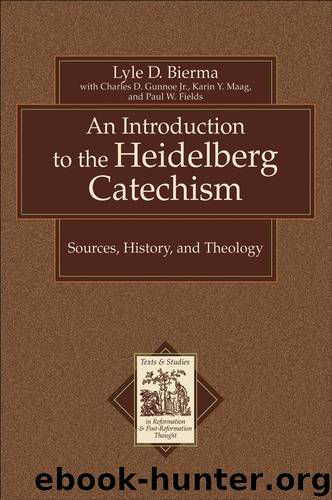An Introduction to the Heidelberg Catechism by Lyle D. Bierma

Author:Lyle D. Bierma
Language: eng
Format: epub
Publisher: Baker Publishing Group
Published: 2013-08-12T16:00:00+00:00
Introduction
Lyle D. Bierma
Authorship, Date, and Purpose
Surviving source material on the origin of the Catechesis minor, or Smaller Catechism (SC), and so-called Catechesis maior, or Larger Catechism (LC), is nearly as sparse as the material on the origin of the Heidelberg Catechism (HC) itself. What few data do exist, however, have usually been thought to point to Zacharias Ursinus as the author of both documents. The LC has been linked to Ursinus ever since its first appearance in print in a volume of his theological treatises in 1584, the year after his death, and then again, under a different title, in Reuter’s collection of Ursinus’s works in 1612.[1] Reuter also included the first published version of the SC, to whose title were appended the words “written in the year 1562 by Dr. Zacharias Ursinus; produced now for the first time from the library and original manuscript [autographo] of the author.”[2] In his introduction, Reuter informs the reader that the two catechisms had been composed by order of the magistrate—the larger for studious adults and advanced students and the smaller for the general population and children—and that once they had been approved, a significant part of the HC was taken from them.[3] This implied that Ursinus could have written the LC no earlier than September 1561, the time of his arrival in Heidelberg, and no later than sometime in 1562, the date Reuter ascribes to the companion SC.
Three centuries later, August Lang became the first to challenge some of these claims. He argued that the LC had probably originated in the context of Ursinus’s teaching at the Sapience College before the commissioning of the HC and that it did not serve directly as a source for the text of the HC. He was also convinced that the SC was an abridgement of the LC but that there were still significant differences between the two catechisms in structure and content. These differences could best be explained by the influence on the SC of the same committee that oversaw production of the HC itself.[4] Indeed, as Neuser would assert a half century later, the SC was not the work of Ursinus alone but was “a committee project.”[5]
More recent research has helped to clarify this picture. In 1972, Erdmann Sturm called attention to important information he had discovered in the inaugural address Ursinus had delivered in September 1562 upon assuming the post of professor of Dogmatics at the University of Heidelberg. First, Ursinus indicates that the territorial catechism currently in preparation was just about ready. Second, he reports that it had been decided that his first course of university lectures should offer “a summary of doctrine” (summam doctrinae) that fell somewhere between a rudimentary catechism and a detailed treatment of the traditional theological loci. None of his extant writings fits the description of this “summary of doctrine” better than his “Catechesis, Summa Theologiae,” the so-called Catechesis maior. That would suggest, then, that he developed the LC sometime in late 1562 and that whatever impact it
Download
This site does not store any files on its server. We only index and link to content provided by other sites. Please contact the content providers to delete copyright contents if any and email us, we'll remove relevant links or contents immediately.
| Book of Common Prayer | Catechisms |
| Devotionals | Hymns & Hymnals |
| Meditations | Monasticism & Asceticism |
| Pentecostal & Charismatic | Prayerbooks |
| Rites & Ceremonies | Sacraments |
More Language of Letting Go: 366 New Daily Meditations by Melody Beattie(2452)
To Light a Sacred Flame by Silver RavenWolf(2355)
How Proust Can Change Your Life by Alain De Botton(2263)
The Secret Power of Speaking God's Word by Joyce Meyer(2254)
Curse Tablets and Binding Spells from the Ancient World by Gager John G.;(1512)
A TIME TO KEEP SILENCE by Patrick Leigh Fermor(1499)
The Gnostic Gospel of St. Thomas by Tau Malachi(1414)
Anxious for Nothing by Max Lucado(1403)
7 Secrets of Divine Mercy by Vinny Flynn(1394)
From Good Goddess to Vestal Virgins: Sex and Category in Roman Religion by Ariadne Staples(1344)
365 Tao: Daily Meditations by Ming-Dao Deng(1303)
To Ride a Silver Broomstick by Silver RavenWolf(1282)
all by Unknown Author(1243)
Anam Cara by John O'Donohue(1229)
To Stir a Magick Cauldron by Silver RavenWolf(1220)
The Sacred Enneagram by Christopher L. Heuertz(1201)
The Fasting Edge by Jentezen Franklin(1185)
100 Days of Thanks by Thomas Nelson(1175)
The Poems of Rowan Williams by Rowan Williams(1073)
